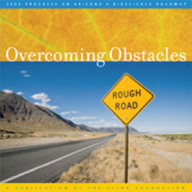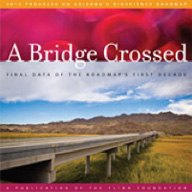The years 2002-2012 saw the rise of the biosciences throughout Arizona following the launch of Arizona’s Bioscience Roadmap.
Arizona developed a solid research infrastructure with new institutes and facilities, from Flagstaff to Tucson, and focused resources on its top strengths—neurosciences, cancer research, bioengineering, precision medicine, and diagnostics.
Top faculty and researchers from around the country were recruited. Incubators and accelerators formed, bioscience clusters took shape, STEM education saw a newfound emphasis, and collaborations and partnerships grew among institutions.
During this time period, Arizona saw 30,000 new bioscience and hospital jobs along with the addition of 200 new firms. And bioscience wages were nearly one-third higher than the average private-sector salary.
The successes and challenges of the Roadmap’s first decade are captured below in progress reports, news stories and data. Also found on this page is the original Arizona’s Bioscience Roadmap report from 2002 and regional roadmaps for southern and northern Arizona.
Progress Reports 2003-2012
During the first decade of Arizona’s Bioscience Roadmap, the Flinn Foundation produced an annual brochure capturing Arizona’s bioscience performance data and significant developments. This series of publications showing the Roadmap’s substantial progress can be read and downloaded below.
Roadmap Reports
News Stories 2002-2012
Bioscience news stories from 2002-2012 can be accessed at Bioscience News and Updates.
Key Data 2003-2012
An update of Roadmap progress by Battelle in early 2013 revealed the following data on key measures.
Jobs: From 2002 to 2011, Arizona bioscience jobs increased by 45%, adding more than 30,700 jobs for a total of 99,018. The U.S. posted a 12% gain during this span. In 2011, jobs in Arizona’s non-hospital subsectors grew by 14%. During the economic recovery (2009-11), Arizona bioscience jobs increased by 11% compared to no gain across the state’s private sector.
Firms: The number of bioscience establishments in Arizona rose 31% from 2002 to 2011, increasing from 682 to 892. This compares to 23% growth for the U.S. The research, testing, and medical-labs subsector remains the largest in Arizona, with 466 establishments, and since 2002 has expanded the fastest, growing 59%.
Wages: Bioscience workers in Arizona earn an average salary of $56,328, compared to $44,098 for all private-sector industries, or 28% higher. From 2002 to 2011, Arizona bioscience salaries increased 44%.
NIH Grants: From 2002 to 2012, Arizona’s funding from the National Institutes of Health grew slightly faster (19%) than the overall U.S. (18%), but much less than the top-10 funded states (31%). Arizona had consistently outpaced the top-10 states in growth rates until 2012, when it slipped as a result of increased competition nationally for constrained NIH funds. Arizona’s share of the national NIH funding pool remains nearly the same as it was in 2002.
R&D Expenditures: Bioscience-related academic research and development expenditures at Arizona’s universities reached a record of $452 million in 2011. This represents a 55% gain since 2002, though trails overall U.S. growth of 74%. Arizona’s growth had outpaced the nation until 2009.
Venture Capital: Arizona’s 2012 levels dropped 68% from 2011 to $22 million, while national VC investment declined by 49%. The amount of private risk capital invested in Arizona bioscience firms was the lowest since 2009, following marked improvement in 2011.
Entrepreneurialism: From 2002 to 2011, Arizona’s universities have shown cumulative steady gains in bioscience intellectual property – invention disclosures, patent applications, patents issued, licenses and options executed, gross license income, and bioscience startup companies. During this period, Arizona’s public universities spun off 67 bioscience startups, generated nearly $19 million in adjusted gross license income, and received 180 bioscience patents.
Implementation: Of the 19 actions recommended by Battelle in 2002 to achieve over 10 years, progress has been made on all 19, including substantial progress on 10.
















